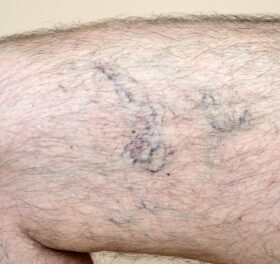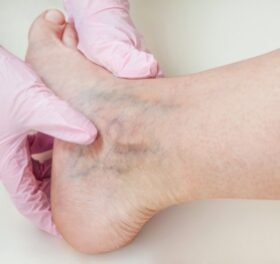If you’re considering sclerotherapy as a treatment for varicose veins or spider veins, you may have some concerns about how it affects your circulation. Sclerotherapy is a minimally invasive procedure commonly used to treat these vein conditions. At Vein Treatment Clinic, we specialize in providing effective vein treatments, including sclerotherapy, and we’re here to address your concerns and provide you with the information you need to make an informed decision.
What Is Sclerotherapy?
Sclerotherapy involves injecting a special solution called a sclerosant into the affected veins. This solution irritates the lining of the treated veins, causing them to collapse and eventually fade away. The body then reroutes the blood flow through healthier veins, restoring proper circulation. Sclerotherapy is primarily used for treating spider veins and small to medium-sized varicose veins on the surface of the skin.
Effects on Circulation
It’s important to note that sclerotherapy does not negatively affect your overall circulation. During the procedure, the sclerosant is carefully injected into the targeted veins, ensuring that the solution only affects the treated veins. The solution is not introduced into the larger veins responsible for carrying blood to and from the heart. This means that healthy veins continue to function normally, facilitating proper circulation throughout your body.
Additionally, the treated veins that have collapsed and closed off after sclerotherapy are no longer actively participating in circulation. Over time, your body naturally absorbs these treated veins, and blood flow is redirected to nearby healthy veins. This redirection of blood flow is a natural process that does not impact your overall circulation in any negative way.
Safety Considerations
While sclerotherapy is generally safe and well-tolerated, it’s essential to discuss any concerns with your board-certified vein doctor at Vein Treatment Clinic. During your initial consultation, we thoroughly review your medical history, including any known allergies or pre-existing conditions that could affect the success or safety of the procedure. This personalized approach ensures that sclerotherapy is suitable for you and tailored to your specific needs.
Possible Side Effects
Like any medical procedure, sclerotherapy carries a small risk of side effects. The most common side effects include temporary itching, redness, and bruising at the injection site. These symptoms typically resolve on their own within a few days or weeks. In rare cases, individuals may experience allergic reactions to the sclerosant used. However, these instances are uncommon, and our experienced vein doctors carefully select the appropriate sclerosant based on your medical history and individual needs.
Duration and Recovery
One of the advantages of sclerotherapy is its minimal downtime. The procedure itself usually takes about 30 minutes, depending on the extent of treatment required. After the procedure, you can resume your daily activities immediately, although it’s important to follow your vein doctor’s post-procedure instructions. These instructions may include wearing compression stockings, avoiding vigorous exercise for a short period, and keeping the treated areas protected from direct sunlight.
Benefits of Sclerotherapy
Sclerotherapy offers several benefits as a treatment for spider veins and varicose veins. Understanding these advantages can help you make an informed decision about whether sclerotherapy is the right choice for you. Here are some key benefits:
- Minimally Invasive: Sclerotherapy is a minimally invasive procedure that does not require surgery or general anesthesia. It involves only small injections into the affected veins, making it a less invasive alternative to surgical treatments.
- Quick and Convenient: The procedure typically takes around 30 minutes to complete, depending on the number and size of the treated veins. With minimal downtime, you can easily fit sclerotherapy into your busy schedule.
- High Success Rate: Sclerotherapy has a high success rate in treating spider veins and small to medium-sized varicose veins. It effectively reduces the appearance of these veins, leading to improved cosmetic outcomes and increased self-confidence.
- Versatile Treatment: Sclerotherapy can be used to treat veins on various parts of the body, including the legs, hands, face, and chest. This versatility allows for comprehensive treatment options, addressing a wide range of vein concerns.
Choosing Sclerotherapy as a Treatment Option
If you’re considering sclerotherapy as a treatment for your spider veins or varicose veins, it’s important to understand the factors that make you a suitable candidate. Here are some considerations when choosing sclerotherapy:
- Size of the Veins: Sclerotherapy is most effective for small to medium-sized veins. Larger veins may require alternative treatments such as endovenous laser ablation or radiofrequency ablation, which your vein doctor can discuss with you if necessary.
- Medical History: Your medical history plays a crucial role in determining your eligibility for sclerotherapy. Certain conditions, such as blood clotting disorders or pregnancy, may affect the safety and effectiveness of the procedure. It’s essential to discuss your medical history with your vein doctor to ensure that sclerotherapy is the right choice for you.
- Realistic Expectations: It’s important to have realistic expectations about the outcome of sclerotherapy. While the procedure can significantly reduce the appearance of spider veins and varicose veins, it may not eliminate them entirely. Your vein doctor can provide you with a clear understanding of the expected results during your consultation.
Post-Treatment Care and Long-Term Results
After undergoing sclerotherapy, proper post-treatment care is essential to ensure optimal results and minimize potential complications. Here are some guidelines for post-treatment care:
- Compression Stockings: Your vein doctor may recommend wearing compression stockings after the procedure. These stockings apply gentle pressure to the treated areas, helping to reduce swelling, promote healing, and maintain the desired results.
- Physical Activity: While you can resume your daily activities immediately after sclerotherapy, it’s advisable to avoid vigorous exercise and activities that put excessive strain on the treated veins for a few days. Your vein doctor will provide specific recommendations based on your individual situation.
- Sun Protection: Protecting the treated areas from direct sunlight is crucial to avoid complications such as hyperpigmentation. Apply sunscreen with a high SPF and cover the treated areas with clothing or protective garments when going outside.
Long-term results of sclerotherapy are generally positive, but it’s important to understand that new spider veins or varicose veins may develop over time due to various factors. Maintaining a healthy lifestyle, including regular exercise, maintaining a healthy weight, and wearing compression stockings can prevent the recurrence of veins and promote overall vein health.
At Vein Treatment Clinic, our board-certified vein doctors provide expert care, taking into consideration your medical history and specific needs. If you’re considering sclerotherapy or any other vein treatment, we offer hassle-free insurance verification and have state-of-the-art locations across the United States, including New York, New Jersey, Long Island, California, and Washington DC. Schedule a consultation and take the first step toward healthier veins and improved quality of life.











